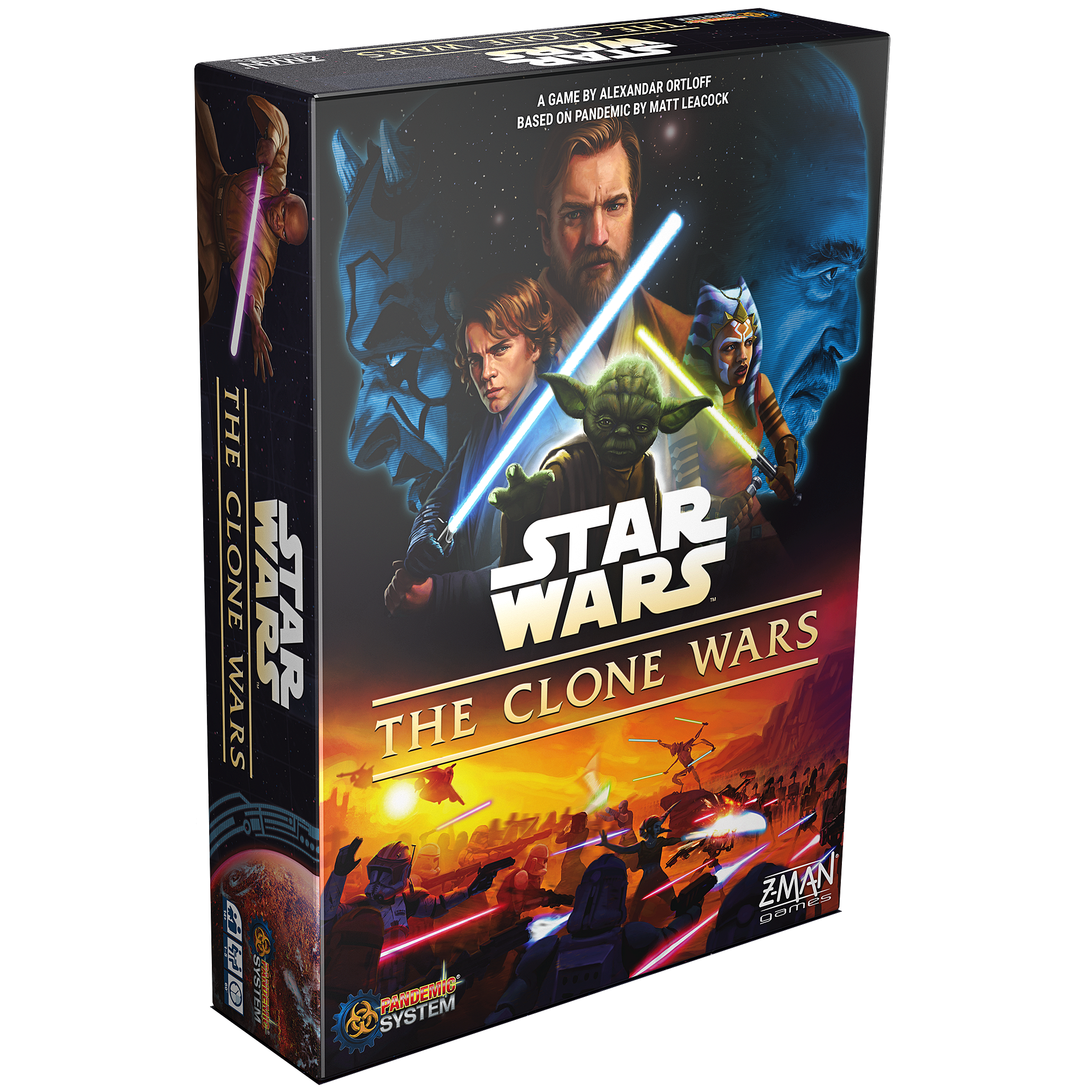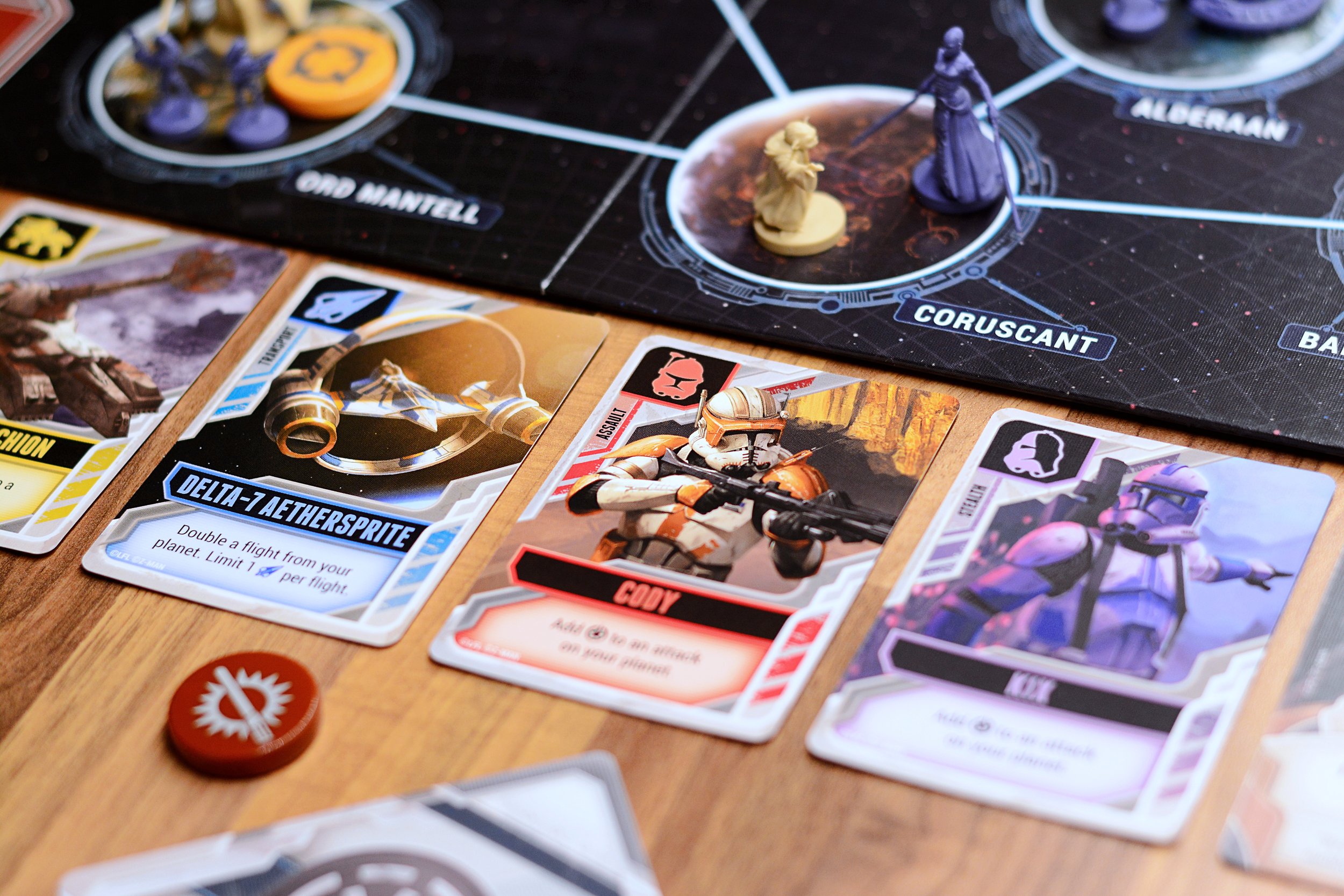Star Wars: The Clone Wars - A Solo Review
Image: Z-Man Games
Introduction
“A long time ago in a galaxy far, far away…”
Has there ever been a more iconic movie quote than the one plucked from the Star Wars universe? If I'm being completely honest, I realize this statement is open to debate but few films have made such an impression on me as the Star Wars universe. It went so far that I ran around the house wearing a housecoat while swinging a "light saber" which consisted of empty toilet rolls I had glued together and painted light blue. This went on for three days until my then-wife ran out of patience and begged me to go back to work. Suffice it to say that I was more than a little bit excited to take a closer look at Star Wars: The Clone Wars, the latest iteration of the Pandemic formula. Despite a couple of minor niggles, I really enjoyed my time solo-playing the previous entry to the series namely World of Warcraft: Wrath of the Lich King. Can Star Wars: The Clone Wars manage to yet again provide a fresh take on this tried and true game design?
Full disclosure: A review copy of Star Wars: The Clone Wars was kindly provided by publisher Asmodee Nordics.
Components & artwork
World of Warcraft: Wrath of the Lich King impressed me with its high level of production quality and Star Wars: The Clone Wars continues that trend admirably. In particular, the sculpts for the larger hero and villain miniatures are really quite something, featuring a high level of detail and dynamic poses which ultimately lends the miniatures a lot of character. Lord knows not every single board game under the sun requires plastic minis to provide an enjoyable visual and tactile experience but in this case, they certainly result in a great deal of delight. Similarly, I found the artwork to be of exceptionally high quality throughout with accurate representations of key characters from Star Wars lore. Also, any board game that features acrylic tokens to denote tracks and resources gets an A in my book! Similarly, I had no issues learning the game from the included manual but then again that may be the result of being fairly familiar with the core game system from the outset.
Photo: Fredrik Schulz / Table for ONE
Gameplay
The galaxy is in turmoil. Under the command of the knights of the Jedi order, clone troopers from the Galactic Republic clash with the Separatist droid army as both sides vie for control over the planets engulfed in war. You take on the role of the Jedi knights as they traverse the galaxy whilst battling the droid armies of Count Dooku and the separatist alliance in an attempt to thwart the forces of evil. Seeing how Star Wars: The Clone Wars is a cooperative game design, the solo mode simply consists of you assuming control of two hero characters with alternating turns between each Jedi. As for the core game experience, Star Wars: The Clone Wars never strays far from what has made Pandemic one of the most beloved board game designs ever published. Damage control is the name of the game and it’s something that you will feel the pressure of within minutes of play. In terms of covering the basic concepts, rather than rehashing my review of World of Warcraft: Wrath of the Lich King I’ll instead focus on what makes Star Wars: The Clone Wars stand out as its own unique game. There are two key aspects that differentiate this game from previous installments to the series namely missions and villains.
Photo: Fredrik Schulz / Table for ONE
World of Warcraft: Wrath of the Lich King introduced a system in which you needed to complete three quests in order to gain access to the titular archnemesis. Although I considered it a novel approach to expand upon the formula, in practice the quest system boiled down to rolling dice and discarding cards at certain geographical locations on the board in order to satisfy a specified number of target icons. To a certain extent, that same system is also implemented in Star Wars: The Clone Wars albeit in a slightly more refined manner. Rather than seeding the board at the start of the game with three fixed zones, in Star Wars: The Clone Wars players instead undertake missions that are drawn from a deck of cards off to the side of the main board. In addition to specifying the number of successful icons needed to complete the mission and on which planet, many cards also have a “When completed” effect that adds a layer of dynamism. Not a deep layer mind you but one nonetheless.
Rather than the more static nature of its predecessor, utilizing a deck of cards that changes over the course of the game to determine where and how missions are resolved infuses Star Wars: The Clone Wars with a sense of unpredictability and dare I say urgency. Not knowing which planet will need your assistance next or which specific type of cards can be used to boost the roll of the die forces you to consider not only the geographical location of the Jedi knights on the board but also the distribution of cards between each character. Should you allow each character to specialize, or approach the game as jacks of all trades? It’s also the case that it feels more true to the source material, considering how the titular conflict spanned over countless planets and star systems where Jedi knights conducted operations of varying nature and scale.
I told you, or at the very least strongly implied, that I’m in fact a huge Star Wars nerd. Don’t judge me.
Photo: Fredrik Schulz / Table for ONE
The second aspect that Star Wars: The Clone Wars refines compared to its predecessor concerns the villains. Unlike World of Warcraft: Wrath of the Lich King which featured only one nemesis, Star Wars: The Clone Wars gives the solitaire player the opportunity to take up the fight against no less than four villains plucked from the Sith archives. This is a design decision that I applaud for a couple of reasons. First, it gives the game a much-needed boost of variability and subsequently longevity. Not only are there more villains to choose from but it’s also clear that author Alexander Ortloff has put some effort into designing each antagonist to model their source counterpart. This is achieved by having the actions of each villain determined by a corresponding deck of cards. Once the current Jedi has finished resolving their actions, the top card of the villain deck is flipped face-up which determines what actions your archnemesis will perform.
This gives each villain their own unique characteristics that correspond surprisingly well to the source material. For example, General Grievous wants to essentially “spread the disease” by populating planets with more and more droid armies. Whereas Darth Maul is all about spreading terror across the galaxies by quickly accumulating power which results in rapidly advancing along the threat track. Secondly, having a villain present on a planet prevents the Jedi knights from undertaking missions thus acting as an even more stubborn roadblock. This requires you to spend precious turns and resources removing the antagonist from the board, efforts you would rather spend on completing missions and preventing planets from becoming overpopulated with droid armies. Another improvement from World of Warcraft: Wrath of the Lich King that has been implemented in Star Wars: The Clone Wars concerns the outbreak cards. Rather than having them being part of the hero deck of cards which felt a bit too random in my mind, here it’s instead incorporated into the villain deck meaning that there is a one in six chance of drawing the invasion card. Not only does this reduce the swingy nature of this particular aspect of the game design but it also feels far more thematically coherent to have the villain make their move rather than the heroes accidentally stumbling upon the card in question when drawing a new hand etc.
Photo: Fredrik Schulz / Table for ONE
But for all my songs of praise, there is one thing about Star Wars: The Clone Wars that doesn’t sit right with me and that concerns the final act of the game. Once you have completed the designated number of missions, the game enters the finale stage representing the crescendo of the overall story arc that has thus unfolded. In practice, this means having the villain retreat to a specific planet upon which the Jedi knights will have to undertake one or several final tasks often in the form of missions. However, unlike the first act where the villain prevented you from undertaking missions before removing them from the board here they just… occupy space. You are free to undergo mission attempt after mission attempt all while the villain simply stares moodily at you. What’s supposed to be this epic, grand finale where the heroes are finally standing face to face with their archnemesis instead boils down to simply ticking the boxes and making sure you have enough cards to mitigate an unlucky roll of the die. I would have loved to see the villain becoming even more aggressive rather than passive, as it reduces the buildup to an anticlimax. Is it an improvement over World of Warcraft: Wrath of the Lich King? Undeniably. Is it perfect? Not by a long shot but then again few things are.
Final thoughts
It never ceases to amaze me how designers are able to not only iterate but also improve on a formula that was first introduced in 2008 (!). But the fact of the matter is that Star Wars: The Clone Wars stands as a testament to this evolution over time, as this latest instantiation definitely shows there is still life in the Pandemic game system to further explore and expand upon. From a thematic standpoint, I personally think this is one of the best implementations to date and one that merges gameplay and narrative into a very enjoyable solo board game experience.




